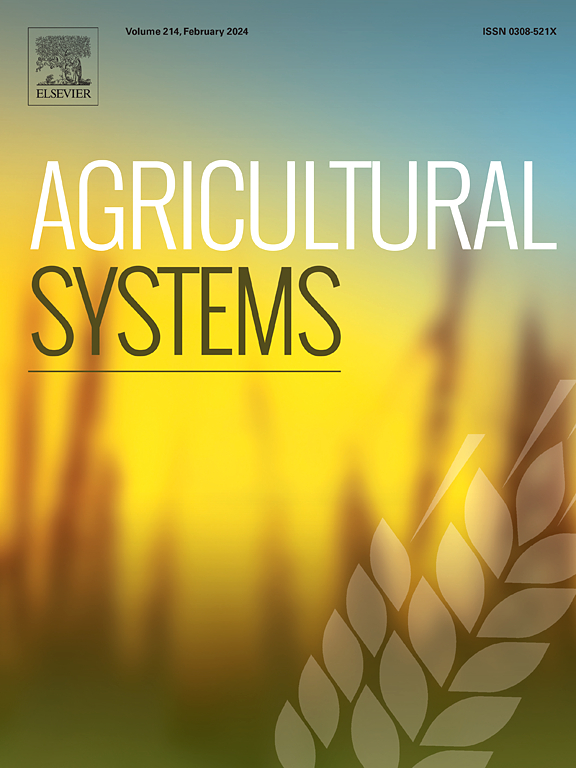Farmer decision-making on agri-environmental schemes: An agent-based modelling approach to evaluate different policy designs in Saxony, Germany
IF 6.1
1区 农林科学
Q1 AGRICULTURE, MULTIDISCIPLINARY
引用次数: 0
Abstract
CONTEXT
Agri-environmental schemes (AES) are intended to promote sustainable agricultural management. However, in the context of the European Union's Common Agricultural Policy, AES in their current implementation have not met expectations regarding their potential to protect biodiversity and ecosystem services. Model-based analyses are particularly suitable for investigating how policy measures should be designed to achieve greater acceptance.
OBJECTIVE
The aim of this study is to use an agent-based model to critically evaluate the impact of changes in agricultural policies on AES adoption rates taking the Mulde River Basin in Germany as an example.
METHODS
Based on data from semi-structured interviews and an online survey, farmers' decision-making in the agent-based model is divided into two main steps: First, it is determined whether farmers are open to adopt an AES, regardless of economic AES contract characteristics. If so, in a second step, their actual adoption is calculated based on the compensation individual farmers require for specific contract designs.
RESULTS AND CONCLUSIONS
The model suggests that changes of AES contract design have more influence on adoption rates than changes in openness of the farmers. At present, limited openness is not the decisive reason for overall low adoption rates. Nevertheless, we find that an expansion of advisory support only fosters adoption if advice promotes farmer openness, which is currently not the case for all considered AES. In addition, social influence between farmers further increases adoption, especially if a farmer's network is large and influential.
SIGNIFICANCE
By systematically assessing the impact of changes in policy design, we show how the potential of the AES could be exploited to a greater extent. Furthermore, we discuss how such a model can be used in biophysical analyses to quantify the environmental impact of AES adoption.

农民对农业环境方案的决策:一个基于主体的建模方法来评估德国萨克森州不同的政策设计
农业环境计划(AES)旨在促进可持续农业管理。然而,在欧洲联盟共同农业政策的背景下,AES目前的实施并未达到其保护生物多样性和生态系统服务的潜力方面的预期。基于模型的分析特别适合于调查应该如何设计政策措施以获得更大的接受度。本研究的目的是以德国穆尔德河流域为例,使用基于主体的模型来批判性地评估农业政策变化对AES采用率的影响。方法基于半结构化访谈和在线调查数据,将基于主体模型的农民决策分为两个主要步骤:首先,确定农民是否愿意采用AES,而不考虑经济AES合同特征;如果是这样,在第二步中,他们的实际采用是根据个别农民对特定合同设计的补偿要求来计算的。结果与结论该模型表明,AES合同设计的变化对采用率的影响大于农户开放度的变化。目前,有限的开放性并不是整体采用率低的决定性原因。然而,我们发现咨询支持的扩大只有在建议促进农民开放的情况下才会促进采用,而目前并非所有考虑的AES都是如此。此外,农民之间的社会影响力进一步增加了采用率,特别是如果农民的网络很大且有影响力的话。通过系统地评估政策设计变化的影响,我们展示了如何在更大程度上利用AES的潜力。此外,我们讨论了如何在生物物理分析中使用这样的模型来量化采用AES对环境的影响。
本文章由计算机程序翻译,如有差异,请以英文原文为准。
求助全文
约1分钟内获得全文
求助全文
来源期刊

Agricultural Systems
农林科学-农业综合
CiteScore
13.30
自引率
7.60%
发文量
174
审稿时长
30 days
期刊介绍:
Agricultural Systems is an international journal that deals with interactions - among the components of agricultural systems, among hierarchical levels of agricultural systems, between agricultural and other land use systems, and between agricultural systems and their natural, social and economic environments.
The scope includes the development and application of systems analysis methodologies in the following areas:
Systems approaches in the sustainable intensification of agriculture; pathways for sustainable intensification; crop-livestock integration; farm-level resource allocation; quantification of benefits and trade-offs at farm to landscape levels; integrative, participatory and dynamic modelling approaches for qualitative and quantitative assessments of agricultural systems and decision making;
The interactions between agricultural and non-agricultural landscapes; the multiple services of agricultural systems; food security and the environment;
Global change and adaptation science; transformational adaptations as driven by changes in climate, policy, values and attitudes influencing the design of farming systems;
Development and application of farming systems design tools and methods for impact, scenario and case study analysis; managing the complexities of dynamic agricultural systems; innovation systems and multi stakeholder arrangements that support or promote change and (or) inform policy decisions.
 求助内容:
求助内容: 应助结果提醒方式:
应助结果提醒方式:


